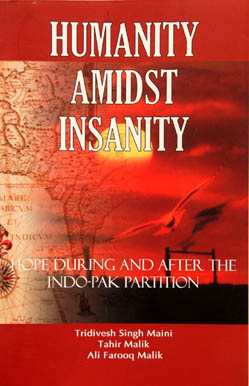Sagas of Partition
By Belu Jain Maheshwari
The Tribune: December 21, 2008
Humanity Amidst Insanity — Hope During and After the Indo-Pak Partition
by Tridivesh Singh Maini, Tahir Malik and Ali Farooq Malik.
UBSPD, New Delhi.
Pages 186. Rs 295.
IN the Indian subcontinent, no historical event has left a greater impact then Partition. The vivisection of the country continues to find an echo in the collective minds of the people of this region even 60 years later. The scars of the holocaust run deep; its ramification can be felt in every sphere — social, political, religious or economic.

India and Pakistan both bear their own burdens, with many issues still smouldering. The issue of Kashmir, fanning of terrorism, spiralling defence budgets, which neither country can ill-afford, to defend the no-man’s land. The many wars fought to no avail, resulting loss of young lives on the borders. The political use of the bogey called Pakistan by Indian politicians and vice versa. But the deepest, the unkindest is the use of Partition, to stigmatise the minority community on both sides.
Partition did not solve any problems, it fostered more. Communalism became entrenched in the politico-religious consciousness of the people. The psyche of the nation was destroyed. As we all know, it is not the bricks and mortar which make a nation, it is the feeling of oneness, of shared consciousness of a nation state, and that is what was shattered.
Partition has evoked a great body of work, be it films, poetry, literature or arts. As an event, it has attracted historians of all hues. Some works have been very well researched, not only by historians of the sub-continent but by exceptional researchers’ world over. The theme has been woven in many languages; the collective works would fill a library.
So, when I got this volume, written jointly by a young researcher from India, Tridivesh Singh Maini, and two Pakistani journalist, Tahir Malik and Ali Farooq Malik, I thought another one on the done-to-death topic, but the book drew my attention right from the cover itself. As the stories unfolded, the significance and the timing of the book were brought home.
The book is relevant because since the Kargil war, a churning of minds is taking place. It is not state sponsored, it is not overt, but it is still palpable. People are coming to terms with the Radcliffe Award; the idea of two nation states co-existing with peace is taking root among individuals of both countries.
This volume is another brick in the process of healing. It does not dismiss the holocaust; it actually addresses pertinent questions that had been left unanswered. Did social barriers exist between the Hindus and Muslims even before Partition was announced? Was the centuries-old animosity the reason for acts of barbarism during Partition?
The book is well researched; the methodology used is oral history. The authors are aware of the pitfalls of this source but agree with Urvashi Butalia, that such narratives "often flow into each other in terms of temporal time, they blur the somewhat rigid time frames within which history situates itself". Post-memory is also used, but with the knowledge that it subsumes the space for remembrance, more broadly available through cultural and public and not merely individual and personal acts of remembrance, identification and projection.
There are 12 Indian and 11 Pakistani interviewees. The stories are well documented, with drama kept to the minimum. They reveal that even amidst chaos and barbarianism, there are human beings who keep alive the spirit of courage, generosity even at the risk of losing their own lives. The concept of Punjabiat has been analysed succinctly. The common language, customs, shared traditions, love of the land helps in understanding Punjabiat.
This book is timely as both communities have used communal violence to fight and settle old and new scores. The authors bring out the point that religious differences were not the reason for Partition, but was a depraved act of an outgoing colonial power ignited from below by the lumpen elements. One of the narratives of Amar Singh Dhillon, going from village to village to build public opinion against perpetuating atrocities against the Muslims left in the Sikh territory, shows what good leadership can achieve. How places of worship became rescue shelters even during the worst phase of religious obscurantism and fanaticism.
In today’s fast-changing, inter-connected and technology-driven world, if the two developing countries have to modernise and provide decent living to their citizens, they have to bury the old hatchet and signal peace and tolerance. The generation next needs to work as a catalyst to healing the wounds. The book is a must read, for it keeps hope alive; it is history with a human angle told from the heart.